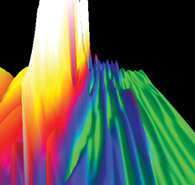by Siegfried Othmer | June 20th, 2011
 Today the web-based newspaper The Daily published a front-page article on Infra-Low Frequency Neurofeedback in application to PTSD. Along with the article there is also a six-minute video that illustrates the training procedure and basic approach. Reporter Katie Drummond did her homework on this topic over a number of months, finally coming out to our office from New York and showing up at our office with a video crew in order to try the training herself and to get acquainted with the principals. Today the web-based newspaper The Daily published a front-page article on Infra-Low Frequency Neurofeedback in application to PTSD. Along with the article there is also a six-minute video that illustrates the training procedure and basic approach. Reporter Katie Drummond did her homework on this topic over a number of months, finally coming out to our office from New York and showing up at our office with a video crew in order to try the training herself and to get acquainted with the principals.
Read More »
Posted in Application of Neurofeedback, Biofeedback, Commentary, Neurofeedback, Professional Issues, PTSD, Veterans, Video | No Comments »
by Siegfried Othmer | May 27th, 2011
 The occasion of Memorial Day 2011 is a good opportunity to reflect on what has been happening in the remediation of PTSD using our latest Infra-Low Frequency (ILF) neurofeedback training. The word breakthrough is over-used, but it does describe the progress that has occurred over the last several years. The most significant event over that time frame was the actual utilization of our methods on a large scale in realistic settings within the military. By now more than 350 service persons have experienced this training at Camp Pendleton, one of six military bases where this work is being conducted. In this fashion, we were able to move from a series of isolated clinical observations in our clinic to a more substantial evaluation in a real-world environment, with independent clinicians guiding the neurofeedback training on the basis of our standard introductory training course, plus the occasional consultation. The occasion of Memorial Day 2011 is a good opportunity to reflect on what has been happening in the remediation of PTSD using our latest Infra-Low Frequency (ILF) neurofeedback training. The word breakthrough is over-used, but it does describe the progress that has occurred over the last several years. The most significant event over that time frame was the actual utilization of our methods on a large scale in realistic settings within the military. By now more than 350 service persons have experienced this training at Camp Pendleton, one of six military bases where this work is being conducted. In this fashion, we were able to move from a series of isolated clinical observations in our clinic to a more substantial evaluation in a real-world environment, with independent clinicians guiding the neurofeedback training on the basis of our standard introductory training course, plus the occasional consultation.
When neurofeedback is used on such a significant scale, even though it is in a clinical context, certain impressions take hold that rise to the level of accepted fact just as surely as if they had arisen out of a formal research program. For example, it was observed that service persons were more consistent in showing up for neurofeedback training than for any other mental health services on offer for PTSD. It is difficult to see such a finding coming out of formal research, where matters are typically more regimented and prescribed. Another advantage of the real-world setting is that a very broad range of symptom presentations is being encountered, as well as a distribution of symptom severity. This allows a comprehensive set of symptoms to be tracked through the training (on the order of 45 in this case), which would be quite atypical for a research design. An additional advantage was the opportunity to see some of the same persons both before and after deployment, so that impressions could be gained about the durability of the training effects in a combat environment. The clinical environment values the individual case, whereas in research such cases would be submerged in statistical analysis and the richness of detail would be lost.
Read More »
Posted in Neurofeedback, PTSD | 9 Comments »
by Siegfried Othmer | April 8th, 2011
 Bringing neurofeedback into a mental health practice means acquiring a working model by means of which all the clinical phenomenology can be reframed in a psychophysiological perspective. Clinical decision-making then emerges largely out of that framework. As the training proceeds, clinical observations are interpreted in terms of that framework and lead to fine-tuning of the clinical strategy. There are two feedback loops here. One involves the client and the feedback signal. The other involves the client and the clinician. The importance of the latter has increased over time as the techniques have strengthened in their impact. Within-session changes in physiological state have to be attended to promptly to steer the training in a propitious direction. This responsiveness, which is observed fairly typically, means that the burden of clinical decision-making has shifted from being a rather freighted decision at the outset to a continual, iterative process that is itself feedback-guided toward the desired objectives. This places the principal burden of competent guidance upon the clinician—more so perhaps than with any other approach. Bringing neurofeedback into a mental health practice means acquiring a working model by means of which all the clinical phenomenology can be reframed in a psychophysiological perspective. Clinical decision-making then emerges largely out of that framework. As the training proceeds, clinical observations are interpreted in terms of that framework and lead to fine-tuning of the clinical strategy. There are two feedback loops here. One involves the client and the feedback signal. The other involves the client and the clinician. The importance of the latter has increased over time as the techniques have strengthened in their impact. Within-session changes in physiological state have to be attended to promptly to steer the training in a propitious direction. This responsiveness, which is observed fairly typically, means that the burden of clinical decision-making has shifted from being a rather freighted decision at the outset to a continual, iterative process that is itself feedback-guided toward the desired objectives. This places the principal burden of competent guidance upon the clinician—more so perhaps than with any other approach.
One proceeds from the basic orientation that the brain must satisfy all of the criteria of a feedback control system. We think in terms of hierarchies here. Firstly, the CNS must assure its own unconditional stability. Allied with this concern is the ability to contain behavioral disinhibition. Second, it must manage set-points of activation of different functional domains. Thirdly, it must arrange for the smooth integration of these functional domains to meet the challenges of life. Clinical targeting then follows this same hierarchy. Promoting brain stability is the first objective. Training for better management of states of activation is the second. Functional integration to manage localized deficits is the third.
Read More »
Posted in Neurofeedback | 2 Comments »
by Siegfried Othmer | April 8th, 2011
 Neurofeedback is a highly promising emerging therapy for the autism spectrum. At issue here is a tool for the direct training of brain function, one that has already shown itself highly effective in addressing a wide range of “mental health” concerns. As has been the case for other therapies, its application to the autism spectrum has been complicated by the inherent complexity of the condition we confront. In the following, we recapitulate the development of neurofeedback for the autism spectrum and give some guidance to both therapists and parents with regard to the choices open to them. Neurofeedback is a highly promising emerging therapy for the autism spectrum. At issue here is a tool for the direct training of brain function, one that has already shown itself highly effective in addressing a wide range of “mental health” concerns. As has been the case for other therapies, its application to the autism spectrum has been complicated by the inherent complexity of the condition we confront. In the following, we recapitulate the development of neurofeedback for the autism spectrum and give some guidance to both therapists and parents with regard to the choices open to them.
Our own work with the autism spectrum using neurofeedback goes back some twenty-five years. In those early days of the field, the principal application of neurofeedback was to Attention-Deficit Hyperactivity Disorder (ADHD), but the very same procedures were clearly also helpful for a variety of other issues. So it came naturally to want to try these methods also with children on the autism spectrum. These early attempts were just as likely to make things worse as they were to make things better, so we quickly placed a virtual fence around autism and decided we did not know enough to venture there. Some years later, a few practitioners in our network reported some good results with newer techniques, so the door was once again opened to working with the autism spectrum.
Read More »
Posted in Application of Neurofeedback, Biofeedback, Disregulation, Neurofeedback | 5 Comments »
by Siegfried Othmer | March 4th, 2011
 Bill Dwyre, sports writer for the Los Angeles Times, took up the cause of Dave Duerson in an emotionally piercing piece on February 25. Duerson shot himself in the heart in order to preserve his brain for head-injury research. What Duerson clearly did not know, along with nearly everyone in the field of medicine, is that his death obliterates most of the evidence of traumatic brain injury that one might ever hope to find. Traditional structural imagery cannot tell the difference between a living brain and a dead one, so it can hardly tell the difference between a functional and a dysfunctional one. One must resort to the more modern functional imaging, whether PET, SPECT, or functional MRI. Now it is too late for that, and Duerson’s contribution must be at another level, namely his impact on the institutional conscience of the NFL. Bill Dwyre, sports writer for the Los Angeles Times, took up the cause of Dave Duerson in an emotionally piercing piece on February 25. Duerson shot himself in the heart in order to preserve his brain for head-injury research. What Duerson clearly did not know, along with nearly everyone in the field of medicine, is that his death obliterates most of the evidence of traumatic brain injury that one might ever hope to find. Traditional structural imagery cannot tell the difference between a living brain and a dead one, so it can hardly tell the difference between a functional and a dysfunctional one. One must resort to the more modern functional imaging, whether PET, SPECT, or functional MRI. Now it is too late for that, and Duerson’s contribution must be at another level, namely his impact on the institutional conscience of the NFL.
To understand traumatic brain injury one has to look beyond the obvious structural features that may be present, even though these will likely rivet one’s attention. The problems lie largely in the functional domain, and must be tested for directly. This is only starting to be done now that functional imaging is becoming commonplace. As a first consequence, we are starting to recognize that a problem exists. But this recognition is propagating only slowly into the realm of actual practice.
Read More »
Posted in Neurofeedback | 3 Comments »
by Siegfried Othmer | January 12th, 2011
 We have worked for many years with Tourette Syndrome, with very equivocal results. It is clearly a heterogeneous condition that does not lend itself readily to a narrow diagnostic description. Mild expressions of the condition may respond readily to a variety of neurofeedback protocols, but more extreme presentations may be more resistant to most approaches. The following case report was provided from a child psychiatry practice in Norway. We have worked for many years with Tourette Syndrome, with very equivocal results. It is clearly a heterogeneous condition that does not lend itself readily to a narrow diagnostic description. Mild expressions of the condition may respond readily to a variety of neurofeedback protocols, but more extreme presentations may be more resistant to most approaches. The following case report was provided from a child psychiatry practice in Norway.
Bodil Solberg, MD is a specialist in Child and Youth Psychiatry and in General Medicine, specialized in diagnosing and treating neuropsychiatric disorders. Dr. Solberg also teaches and supervises cognitive behavioral therapy. Her clinic is part of the Norwegian public health care system.
Read More »
Posted in Application of Neurofeedback, Neurofeedback | 5 Comments »
|
|
Subscribe to Email Newsletter
The EEG Info Newsletter circulates via email at least once a month. A variety of topics related to the Neurofeedback / EEG Biofeedback field are covered in over 300 articles.
|
 Today the web-based newspaper The Daily published a front-page article on Infra-Low Frequency Neurofeedback in application to PTSD. Along with the article there is also a six-minute video that illustrates the training procedure and basic approach. Reporter Katie Drummond did her homework on this topic over a number of months, finally coming out to our office from New York and showing up at our office with a video crew in order to try the training herself and to get acquainted with the principals.
Today the web-based newspaper The Daily published a front-page article on Infra-Low Frequency Neurofeedback in application to PTSD. Along with the article there is also a six-minute video that illustrates the training procedure and basic approach. Reporter Katie Drummond did her homework on this topic over a number of months, finally coming out to our office from New York and showing up at our office with a video crew in order to try the training herself and to get acquainted with the principals.





 The occasion of Memorial Day 2011 is a good opportunity to reflect on what has been happening in the remediation of PTSD using our latest Infra-Low Frequency (ILF) neurofeedback training. The word breakthrough is over-used, but it does describe the progress that has occurred over the last several years. The most significant event over that time frame was the actual utilization of our methods on a large scale in realistic settings within the military. By now more than 350 service persons have experienced this training at Camp Pendleton, one of six military bases where this work is being conducted. In this fashion, we were able to move from a series of isolated clinical observations in our clinic to a more substantial evaluation in a real-world environment, with independent clinicians guiding the neurofeedback training on the basis of our standard introductory training course, plus the occasional consultation.
The occasion of Memorial Day 2011 is a good opportunity to reflect on what has been happening in the remediation of PTSD using our latest Infra-Low Frequency (ILF) neurofeedback training. The word breakthrough is over-used, but it does describe the progress that has occurred over the last several years. The most significant event over that time frame was the actual utilization of our methods on a large scale in realistic settings within the military. By now more than 350 service persons have experienced this training at Camp Pendleton, one of six military bases where this work is being conducted. In this fashion, we were able to move from a series of isolated clinical observations in our clinic to a more substantial evaluation in a real-world environment, with independent clinicians guiding the neurofeedback training on the basis of our standard introductory training course, plus the occasional consultation. Bringing neurofeedback into a mental health practice means acquiring a working model by means of which all the clinical phenomenology can be reframed in a psychophysiological perspective. Clinical decision-making then emerges largely out of that framework. As the training proceeds, clinical observations are interpreted in terms of that framework and lead to fine-tuning of the clinical strategy. There are two feedback loops here. One involves the client and the feedback signal. The other involves the client and the clinician. The importance of the latter has increased over time as the techniques have strengthened in their impact. Within-session changes in physiological state have to be attended to promptly to steer the training in a propitious direction. This responsiveness, which is observed fairly typically, means that the burden of clinical decision-making has shifted from being a rather freighted decision at the outset to a continual, iterative process that is itself feedback-guided toward the desired objectives. This places the principal burden of competent guidance upon the clinician—more so perhaps than with any other approach.
Bringing neurofeedback into a mental health practice means acquiring a working model by means of which all the clinical phenomenology can be reframed in a psychophysiological perspective. Clinical decision-making then emerges largely out of that framework. As the training proceeds, clinical observations are interpreted in terms of that framework and lead to fine-tuning of the clinical strategy. There are two feedback loops here. One involves the client and the feedback signal. The other involves the client and the clinician. The importance of the latter has increased over time as the techniques have strengthened in their impact. Within-session changes in physiological state have to be attended to promptly to steer the training in a propitious direction. This responsiveness, which is observed fairly typically, means that the burden of clinical decision-making has shifted from being a rather freighted decision at the outset to a continual, iterative process that is itself feedback-guided toward the desired objectives. This places the principal burden of competent guidance upon the clinician—more so perhaps than with any other approach. Neurofeedback is a highly promising emerging therapy for the autism spectrum. At issue here is a tool for the direct training of brain function, one that has already shown itself highly effective in addressing a wide range of “mental health” concerns. As has been the case for other therapies, its application to the autism spectrum has been complicated by the inherent complexity of the condition we confront. In the following, we recapitulate the development of neurofeedback for the autism spectrum and give some guidance to both therapists and parents with regard to the choices open to them.
Neurofeedback is a highly promising emerging therapy for the autism spectrum. At issue here is a tool for the direct training of brain function, one that has already shown itself highly effective in addressing a wide range of “mental health” concerns. As has been the case for other therapies, its application to the autism spectrum has been complicated by the inherent complexity of the condition we confront. In the following, we recapitulate the development of neurofeedback for the autism spectrum and give some guidance to both therapists and parents with regard to the choices open to them. Bill Dwyre, sports writer for the Los Angeles Times, took up the cause of Dave Duerson in an emotionally piercing piece on February 25. Duerson shot himself in the heart in order to preserve his brain for head-injury research. What Duerson clearly did not know, along with nearly everyone in the field of medicine, is that his death obliterates most of the evidence of traumatic brain injury that one might ever hope to find. Traditional structural imagery cannot tell the difference between a living brain and a dead one, so it can hardly tell the difference between a functional and a dysfunctional one. One must resort to the more modern functional imaging, whether PET, SPECT, or functional MRI. Now it is too late for that, and Duerson’s contribution must be at another level, namely his impact on the institutional conscience of the NFL.
Bill Dwyre, sports writer for the Los Angeles Times, took up the cause of Dave Duerson in an emotionally piercing piece on February 25. Duerson shot himself in the heart in order to preserve his brain for head-injury research. What Duerson clearly did not know, along with nearly everyone in the field of medicine, is that his death obliterates most of the evidence of traumatic brain injury that one might ever hope to find. Traditional structural imagery cannot tell the difference between a living brain and a dead one, so it can hardly tell the difference between a functional and a dysfunctional one. One must resort to the more modern functional imaging, whether PET, SPECT, or functional MRI. Now it is too late for that, and Duerson’s contribution must be at another level, namely his impact on the institutional conscience of the NFL. We have worked for many years with Tourette Syndrome, with very equivocal results. It is clearly a heterogeneous condition that does not lend itself readily to a narrow diagnostic description. Mild expressions of the condition may respond readily to a variety of neurofeedback protocols, but more extreme presentations may be more resistant to most approaches. The following case report was provided from a child psychiatry practice in Norway.
We have worked for many years with Tourette Syndrome, with very equivocal results. It is clearly a heterogeneous condition that does not lend itself readily to a narrow diagnostic description. Mild expressions of the condition may respond readily to a variety of neurofeedback protocols, but more extreme presentations may be more resistant to most approaches. The following case report was provided from a child psychiatry practice in Norway.